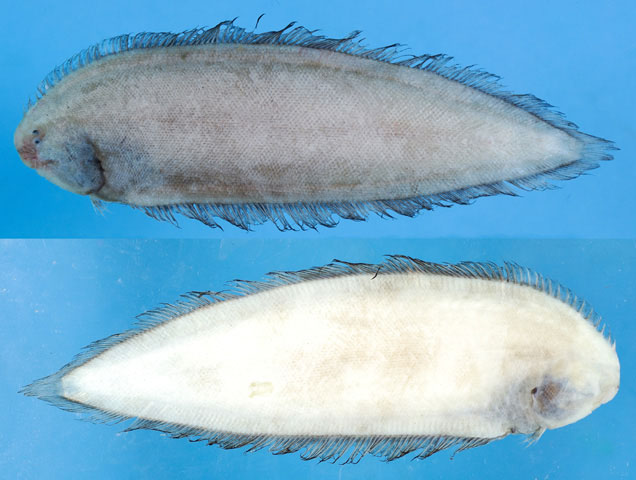| Cynoglossidae (Tonguefishes), subfamily: Symphurinae |
| 14.67 cm SL (male/unsexed); 14.34 cm SL (female) |
|
benthopelagic; marine; depth range 200 - 640 m |
| Northwest Pacific: Taiwan. |
|
Dorsal soft rays (total): 106-111; Anal soft rays: 91-96; Vertebrae: 55-58. This species is distinguished from all its congeners, except S. hondoensis and S. undatus, by its predominant 1-2-3-2-2 ID pattern. It also differs from both abovementioned species in having smaller eye (5.3-7.9% HL vs. 11.0-14.9% HL in S. hondoensis and 11.5-13.8% HL in S. undatus). This species further differs from S. hondoensis
in having 9 abdominal vertebrae (vs. 10). S. megasomus is also distinguished from S. undatus, by having higher fin-ray counts, 106-111 dorsal-fin rays and 91-96 anal-fin rays (vs. 101-105 dorsal-fin rays and 87-91 anal-fin rays) and a uniform straw-colored to dark brown ocular-side coloration (vs. freckled ocular-side pigmentation) (Ref. 82423). |
| This deep-water tonguefish species is known only from the continental shelf and upper continental slope off northeastern and eastern Taiwan; from 471-640 m by research vessels. Polychaetes, small crustaceans and some unidentified detritus were found in the digestive systems of fishes examined. Little else is known regarding the biology of this species (Ref. 82423). |
|
Data deficient (DD); Date assessed: 15 October 2020 Ref. (130435)
|
| harmless |
|
Source and more info: www.fishbase.org. For personal, classroom, and other internal use only. Not for publication.

